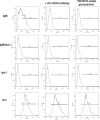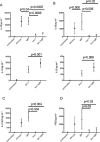LOS oligosaccharide modification enhances dendritic cell responses to meningococcal native outer membrane vesicles expressing a non-toxic lipid A
- PMID: 24152255
- PMCID: PMC4204155
- DOI: 10.1111/cmi.12231
LOS oligosaccharide modification enhances dendritic cell responses to meningococcal native outer membrane vesicles expressing a non-toxic lipid A
Abstract
Outer membrane vesicles (OMV) are released by many bacteria, and contain immunogenic antigens in addition to harmful inflammatory factors, like lipopolysaccharides. Chemically detoxified OMV have been used in vaccines against Neisseria meningitidis (Nm); however, little is known about their interaction with antigen presenting cells. In this study, we investigated the interaction of Nm OMV with human dendritic cells (DC) to gain further understanding of their biological activity. We engineered a novel serogroup B Nm that is unencapsulated (siaD), expresses pentacylated lipid A (lpxL1), hence conferring reduced toxicity, and expresses an lgtB oligosaccharide structure designed to target OMV to DC via DC-SIGN. We show that the lgtB moiety is critical for internalization of NOMV by DC. Furthermore, the lgtB moiety significantly enhances DC maturation, IL-10 and IL-23 production in the presence of a pentacylated lipid A. While different DC phenotypes were observed for each NOMV, this had little effect on Th1 and Th2 cell differentiation; however, lgtBsignificantly increased Th17 cell expansion in the presence of pentacylated lipid A. We believe that lpxL1/lgtB NOMV should be considered further as a vaccine vector, particularly considering the importance of lgtB in antigen uptake and further human studies on antigen-specific responses should be considered.
© 2013 John Wiley & Sons Ltd.
Figures








Similar articles
-
Neisseria meningitidis expressing lgtB lipopolysaccharide targets DC-SIGN and modulates dendritic cell function.Cell Microbiol. 2006 Feb;8(2):316-25. doi: 10.1111/j.1462-5822.2005.00623.x. Cell Microbiol. 2006. PMID: 16441441
-
Neisseria meningitidis native outer membrane vesicles containing different lipopolysaccharide glycoforms as adjuvants for meningococcal and nonmeningococcal antigens.Clin Vaccine Immunol. 2014 Feb;21(2):234-42. doi: 10.1128/CVI.00561-13. Epub 2013 Dec 18. Clin Vaccine Immunol. 2014. PMID: 24351756 Free PMC article.
-
A native outer membrane vesicle vaccine confers protection against meningococcal colonization in human CEACAM1 transgenic mice.Vaccine. 2015 Mar 10;33(11):1317-1323. doi: 10.1016/j.vaccine.2015.01.057. Epub 2015 Feb 4. Vaccine. 2015. PMID: 25662856 Free PMC article.
-
A deeper mining on the protein composition of VA-MENGOC-BC®: An OMV-based vaccine against N. meningitidis serogroup B and C.Hum Vaccin Immunother. 2017 Nov 2;13(11):2548-2560. doi: 10.1080/21645515.2017.1356961. Epub 2017 Oct 30. Hum Vaccin Immunother. 2017. PMID: 29083947 Free PMC article. Review.
-
Exploitation of Neisseria meningitidis Group B OMV Vaccines Against N. gonorrhoeae to Inform the Development and Deployment of Effective Gonorrhea Vaccines.Front Immunol. 2019 Apr 9;10:683. doi: 10.3389/fimmu.2019.00683. eCollection 2019. Front Immunol. 2019. PMID: 31024540 Free PMC article. Review.
Cited by
-
Testing the impact of interpersonal regulatory fit on empathy, helping intentions, and prosocial behaviour.PLoS One. 2022 Jul 18;17(7):e0270462. doi: 10.1371/journal.pone.0270462. eCollection 2022. PLoS One. 2022. PMID: 35849584 Free PMC article.
-
Meningococcal Outer Membrane Vesicle Composition-Dependent Activation of the Innate Immune Response.Infect Immun. 2016 Sep 19;84(10):3024-33. doi: 10.1128/IAI.00635-16. Print 2016 Oct. Infect Immun. 2016. PMID: 27481244 Free PMC article.
-
Lipopolysaccharide engineering in Neisseria meningitidis: structural analysis of different pentaacyl lipid A mutants and comparison of their modified agonist properties.J Biol Chem. 2014 Mar 21;289(12):8668-80. doi: 10.1074/jbc.M114.554345. Epub 2014 Feb 3. J Biol Chem. 2014. PMID: 24492609 Free PMC article.
-
Characterization and Vaccine Potential of Outer Membrane Vesicles Produced by Haemophilus parasuis.PLoS One. 2016 Mar 1;11(3):e0149132. doi: 10.1371/journal.pone.0149132. eCollection 2016. PLoS One. 2016. PMID: 26930282 Free PMC article.
-
Association of O-Antigen Serotype with the Magnitude of Initial Systemic Cytokine Responses and Persistence in the Urinary Tract.J Bacteriol. 2016 Jan 11;198(6):964-72. doi: 10.1128/JB.00664-15. J Bacteriol. 2016. PMID: 26755631 Free PMC article.
References
-
- Agrawal S, Gupta S. Agralwal A. Vaccinia virus proteins activate human dendritic cells to induce T cell responses in vitro. Vaccine. 2009;27:88–92. - PubMed
-
- Banchereau J, Briere F, Caue C, Davoust J, Lebecque S, Liu YJ, et al. Immunobiology of dendritic cells. Annu Rev Immunol. 2000;18:767–811. - PubMed
-
- van Beelen AJ, Zelinkova Z, Taanman-Kueter EW, Muller FJ, Hommes DW, Zaat SA, et al. Stimulation of the intracellular bacterial sensor NOD2 programs dendritic cells to promote interleukin-17 production in human memory T cells. Immunity. 2007;27:660–669. - PubMed
-
- Cambi A, Beeren I, Joosten B, Fransen JA. Figdor CG. The C-type lectin DC-SIGN internalizes soluble antigens and HIV-1 virions via a clathrin-dependent mechanism. Eur J Immunol. 2009;39:1923–1928. - PubMed
Publication types
MeSH terms
Substances
LinkOut - more resources
Full Text Sources
Other Literature Sources

